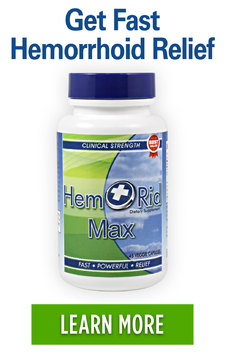Dog Hemorrhoids Treatment Guide - Does Your Dog Have Hemorrhoids and Need Relief?
Posted on 18 June 2018 by Maryanne Johnson
Share this post
Do dog hemorrhoids really exist? Yes, dog hemorrhoids are real, and the best thing you can do is help your pooch get relief.
Hemorrhoids are essentially swollen blood vessels that form either inside of the rectal area or on or around the anal opening. Hemorrhoids are a common issue for both humans and animals, like dogs.
Keep reading to confirm if your erratic German shepherd is suffering from hemorrhoids and how you can treat the condition.
For humans, hemorrhoids occur more often in adults age 50 or older. The tissue holding these clusters of blood vessels and veins weakens as humans age, and this can result in the inflammation of hemorrhoids and amplify their symptoms.
Many times, the case behind the causation of swollen hemorrhoids is a lack of fibrous diet in combination with other elements, like not drinking enough water. For humans and dogs alike, this can result in inflammation and hemorrhoid symptoms.
Can Dogs Get Hemorrhoids?
Both dogs and humans can have either type of hemorrhoids, internal or external. Internal hemorrhoids in dogs are known to bleed after a bowel movement painlessly. External hemorrhoids form small, rubbery bumps around or on the anal opening.
If you are a pet owner, spotting a hemorrhoid on your dog is an easy thing to do, as external hemorrhoids are noticeable due to their round bumpiness near the dog’s anus.
Your dog may be attempting to relieve the hemorrhoid itch by dragging its hindquarters along a rough or textured carpet or by licking its rectum excessively. Hemorrhoids are itchy and animals tend to do whatever it takes to relieve discomfort and itch.
Unlike humans, dogs have scent glands on their anal area that can become swollen or blocked. Their anal area is sensitive and often times, and pet owners misdiagnose hemorrhoids as an issue with these anal glands.
This is why it is important to seek consultation and examination by a vet to prepare the right treatments for your dog.
Symptoms of Dog Hemorrhoids
The occurrence of hemorrhoids is substantially similar between dogs and humans. Both tend to be present and cause flare-ups for older adults and older dogs. Pregnancy is also a contributor for hemorrhoid symptoms because of the additional pressure placed on the lower rectum. Subsequently, we advise double-checking pregnant dogs to see if they're developing hemorrhoids. That way, you can find out on time and see a vet as quickly as possible.
Rectal bleeding can occur in dogs and humans. This can happen directly following the passage of stools, which are typically hard and lack moisture. Blood can also be present in the stools themselves.
Dogs can experience a range of symptoms brought on by hemorrhoids:
- Itchiness
- Hardened stools
- Anal bleeding
- Blood in stools
- Discomfort or pain
- A stinging pain
With these symptoms, one clear fact is that an infected dog will strain to defecate.
Fortunately, because hemorrhoids are common in dogs, there are many methods of treatments for relieving symptoms.
First and foremost, however, as a pet owner, you should seek the official diagnosis from your veterinarian. Some symptoms of hemorrhoids are similar to what any other anal sac disease can cause.
Hemorrhoids frequently are confused with tumors, anal gland blockage, gland inflammation, and other issues. Unlike humans, hemorrhoids in dogs can be a result of another intestinal problem.
After having your dog examined to determine if it does have hemorrhoids, you and your vet can move on to deciding which method of hemorrhoid treatment is most appropriate.
What To Do If Your Dog Has Hemorrhoids
Because hemorrhoids can be easily confused with several other issues, like swollen and inflamed anal glands, tumors, fissures, or rectal prolapse, it is crucial to get confirmation from your veterinarian first.
Determining hemorrhoids in dogs can be a visual inspection of the dog’s anal area or by keeping an eye on its stools and bowel movements for rectal bleeding. Hemorrhoids are itchy, and occasionally dogs will drag their hinds against carpets to satisfy the itch.
Dogs will lick the rectal area excessively in an attempt to gain relief from their symptoms as well.
Improper treatment of hemorrhoids can lead to the condition worsening. Once your veterinarian has confirmed that your dog has hemorrhoids, medications can be implemented.
Your veterinarian can assist you in changing your dog's diet to include more fiber. Another critical aspect of prevention is to ensure that your dog is staying hydrated throughout the day.
There are plenty of home remedies that can be tested to your dog’s preference. A cool bottle of witch hazel placed overnight in the fridge can aid in alleviating itching, burning, and pain.
Your vet will avoid surgery unless it is necessary. Hemorrhoid surgeries, while available as an option, put stress on an animal. Instead, veterinarians opt for topical hemorrhoid creams and diet changes to shrink hemorrhoids and prevent flare-ups.
Dog Hemorrhoid Treatments
Treatments for dog hemorrhoids can range from a change to diet to topical creams, and in severe cases, sometimes surgery. It is best to seek advice in treatment methods from your veterinarian first before trying any yourself.
Treatments for dog hemorrhoids include:
- Topical creams and ointments
- Hemorrhoid Sprays
- Additional fiber
- Change of diet for high fiber foods
- Natural remedies like witch hazel
- Anti-inflammatory medication
- Surgeries or non-operative treatments
Topical creams are frequently used in hemorrhoid treatments. Creams are an easily applied solution for animals and veterinarians will advise pet owners to use them to relieve symptoms.
Hydrocortisone is an ingredient commonly used in anti-itch creams and is safe to use on dogs. Pet stores carry hydrocortisone creams specifically for dogs to help them feel less itchy on the anal area.
Sprays are another form of treatment for dogs that do not like creams or having creams applied to their sensitive rectal area. Sprays also utilize anti-itch ingredients, like creams.
Home remedies for dogs include giving them a few tablespoons of canned pumpkin for fiber, a cool application of witch hazel or aloe vera.
Before enacting home remedies, it is essential to check with your veterinarian to make sure that these methods are safe for your dog.
Occasionally, veterinarians will recommend a change of diet for your dog. Like humans, hemorrhoids can be a result of a diet that lacks fiber. Straining and hardened stools aggravate symptoms and amplify them.
Ensuring that your dog is hydrated throughout the day can also stabilize and soften their bowel movements. This method of prevention aids in relieving straining and constipation.
Especially when extra fiber is concerned, adding lots of water is needed to move food and fiber through the dog’s digestive tract and for stools to absorb the moisture.
In extreme cases, hemorrhoids on your dog may have to be surgically removed, but this shouldn't be any cause for concern. The process will be painless and swift, as long as an expert is in charge. Surgeries can be an excellent way to treat dog hemorrhoids, since they happen once and cure the condition completely.
What Do Hemorrhoids on a Dog Look Like?
Much like humans, hemorrhoids on dogs look like small rubbery bumps that are either red or flesh colored. These are external hemorrhoids and are visible on the dog’s anal area, either on or surrounding the anus.
Internal hemorrhoids are not visible because they are located inside of the rectum. However, internal hemorrhoids produce painless bleeding in the dog’s stools or directly after a bowel movement is made.
Internal hemorrhoids can become prolapsed. A dog can also experience rectal prolapse and hemorrhoids can be confused with this condition. A prolapsed internal hemorrhoid is a mass of swollen blood vessels and veins that becomes lowered through the rectum. Prolapsed hemorrhoids are usually red and coated in mucus.
Preparation H and Hemorrhoids for Dogs
Preparation H is a staple in hemorrhoid treatment for humans, but how does it stand for application on dogs?
Preparation H works by utilizing hydrocortisone as its main ingredient to stop the itching, burning, and discomfort of hemorrhoid symptoms.
Preparation H is one of the most effective topical creams to treat hemorrhoids, and yes, it can be safely used on dogs as well as humans.
Preparation H can be used on dogs in the same way it can be used for humans. Just take a dime-sized amount of Preparation H cream and directly apply it to the dog’s anal area and on any visible external hemorrhoids.
Be sure to use gloves while applying the cream.
While Preparation H is safe for dogs, it is essential to know that their instinct may force them to lick it off once it is applied. There are sprays and other means to discourage a dog from licking off medication that can be found in pet stores or prescribed by a veterinarian.
As with any treatment method, you should make sure to talk to your veterinarian before applying Preparation H or any other topical creams or medications to your dog’s rectal area.
Remember, a dog can develop other health problems with symptoms similar to hemorrhoids'. Failing to identify the actual problem before treatment would therefore be drug misuse, and that can worsen the condition.
Your vet will make sure that your dog has hemorrhoids and not another rectal condition. For example, perianal fistula (or anal fistula), an infection caused by the development of pus in the anal sacs. Your vet will also ensure that your dog receives the most appropriate treatment for its condition for optimal results.





0 comments